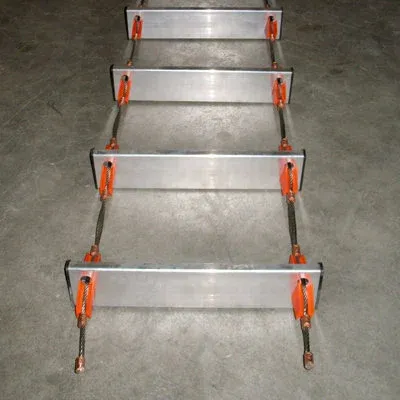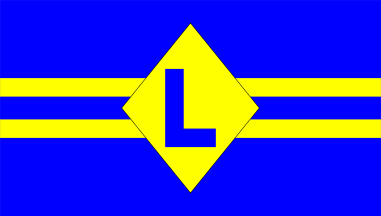Different Types Of Pilot Ladder
Despite being heavily regulated pilot ladders come in various designs. The SOLAS regulations and even ISO 799 do allow a little leeway in material choice when it comes to the components used to make a pilot ladder.
So lets take a look at the regulations for each component we might need to make a pilot ladder.
The Pilot Ladder Side Ropes
The documents we will consider are SOLAS Chapter 5 Regulation 23, IMO Resolution 1045(27) and ISO 799
So IMO 1045(27) states that
• Ropes must be at least 18mm in diameter
• Not less than 24kN breaking strength
• Should be made of manila or other material of equivalent strength, durability, elongation characteristics and grip which has been protected against actinic degradation and is satisfactory to the Administration.
ISO 799 states that
• Ropes must be at least 20mm in diameter
• Not less than 24kN breaking strength
• Each side rope shall be mildew-resistant manila rope meeting ISO 1181:2004,
Quality 1, or a spun thermoset polyester rope with a polypropylene core of a colour that contrasts with the spun polyester
ISO 799 goes on to add
• Alternative side ropes of synthetic material may be used if they:
• Meet the breaking strength and size requirements of 4.2.1;
• Are at least as resistant to elongation under load as the standard ropes described in 4.2.1;
• Have an exterior surface suitable to be grasped by bare hands, similar to manila or spun polyester;
• Are of a thermoset polymer, resistant to deterioration from ultraviolet light; and
• Provide a visual indication of excessive wear, similar to the spun polyester/polypropylene construction described in
So the preferred material is manila but under SOLAS regulations we can pretty much use anything (HMPE, Braided Nylon Rope etc) providing it meets with the IMO’s approval whereas ISO 799 limits us to manila or spun thermoset polyprop rope or a synthetic rope of similar properties. The ISO standard also looks to limit the quality of the manila rope that can be used.
The Pilot Ladder Steps
So IMO 1045(27) states that the steps
• If made of hardwood, they should be made in one piece, free of knots;
• If made of material other than hardwood, they should be of equivalent strength, stiffness and durability to the satisfaction of the Administration;
• The four lowest steps may be of rubber of sufficient strength and stiffness or other material to the satisfaction of the Administration;
• They should have an efficient non-slip surface;
ISO 799 states that
• Steps to be made from hardwood, resilient plastic or rubber
• If made of wood, they are free of knots and uncoated
• Steps have a grooved, patterned , or moulded non-skid surface
• Anti skid adhesive sheeting may not be used
• Step thickness should be a minimum of 25 mm ( excluding the non skid treatment or grooving)
• The lower four steps shall be made of rubber of resilient synthetic material.
So very similar in wording although te IMO seem happy to accept quite a variety of materials whereas ISO limit you to hardwood, plastic or rubber and also insist that the bottom 4 steps are either rubber or synthetic.
So what types of ladder are on the market
Traditional Pilot Ladders
These fall into 2 categories; winch ladders and non-winch ladders.

The winch ladder is thicker at it’s edges making it heavier and more resistant to damage (either from the pilot boat or the winch). The non-winch ladder tries to remain as lightweight as possible to assist the crew in being able to deploy and recover the pilot ladder safety.
In my experience Pilots favourite type of ladder is a winch ladder. The additional weight of the ladder as a result of those chucky wooden steps make this a solid piece of kit. It doesn’t move very much, is less prone to twisting and feels ‘safe’
Non Traditional Pilot Ladders
Plastic Pilot Ladders
These ladders are generally made from plastic (elastomer) are incredibly lightweight and have been further lightened by the addition of cut outs in the ladders spreaders.
A classic example of a plastic ladder is the Goliath from PTR Holland. These ladders are great for the crew as they are incredibly light and easy to deploy but not popular with pilots. The reason for this is their lightweight make them less stable than a traditional wooden pilot ladder. They can be difficult to step on to due to this additional movement and if it’s a long climb are prone to ‘penduluming’ as the pilot climbs. They are usually found on cruise ships or yachts where there light weight is less significant given the sorter climb experienced with these type of vessels.
Aluminium Pilot Ladders
These are somewhat ‘outliers’ in the piloting world. They are not ISO 799 as the strength of aluminium ladders doesn’t usually meet the step strength test requirements of the global standard. Plus they are slippery when wet so really not a good solution for pilot ladders.
We would never recomend buying an aluminium pilot ladder! They are thankfully a very rare sight and tend to fill pilots with distrust for the reason stated.

Dutch pilot Arie Palmers recently witnessed the testing of an aluminium pilot ladder that a manufacturer was claiming to be ISO 799 compliant. It failed miserably further underlining why pilots have little faith in such ladders. The report of his test can be found here
Carbon Fibre Pilot Ladders
These are the new guys on the block produced by C-Quip in New Zealand. Designed for the superyacht market these beautiful, if eyewateringly expensive pilot ladders are ISO 799 compliant according to the manufacturer. Whilst a great technological achievement their price means they have a very limited market for now.

So there we have it. Pilot ladders do come in all shapes and sizes. However if you are looking to source a pilot ladder we would highly recommend
1. You go direct to the manufacturer or trusted reseller
2. You buy ONLY ISO 799 ladders
3. You ensure typre approval is by an IACS registered Classification Society
Fathom Safety can take the confusion of pilot ladder management away with our end to end Pilot Ladder Management Service. Watch this video to find out how we can take the pilot ladder headache away!















